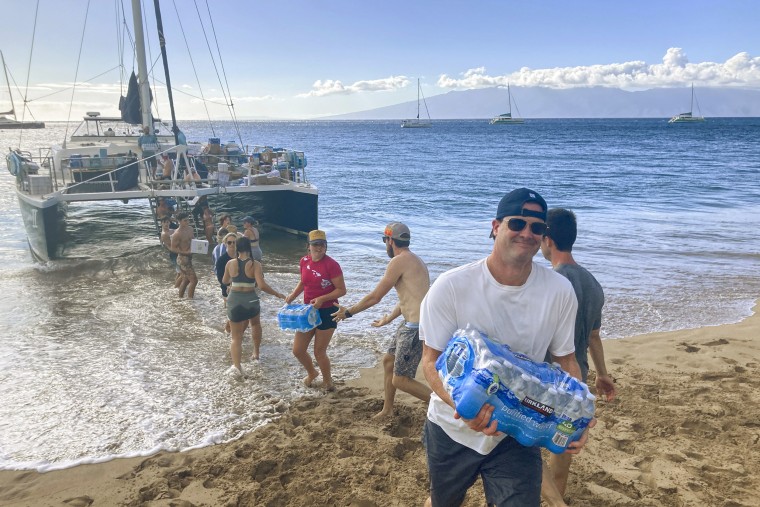The fires that have been burning in Maui since Tuesday could pose long-term health risks to residents due to chemical compounds contaminating the air, water and wreckage, authorities and experts have warned.
The Hawaii State Health Department cautioned Friday that ash and dust from burned buildings might carry toxic chemicals like asbestos and lead. Many destroyed buildings in Lahaina — the hardest–hit community — may have contained these chemicals because they were built before lead and asbestos were phased out of construction in the 1970s.
“Things like lead and asbestos are sort of top of the list. Those are things that are in paint, in buildings, and then do not really get destroyed with burning, so they’re now in the ash and the dust,” said Diana Felton, Hawaii’s state toxicologist.
Felton said that there is some concern that people in Lahaina might inhale lead and asbestos particles in the air but that the bigger worry is that residents might unintentionally ingest the chemicals if they get on clothes or hands.
The fires may also have stirred up arsenic in the soil, because the chemical was used as an herbicide in parts of Hawaii — particularly sugar cane and pineapple fields — in the early 1900s, Felton said. The chemical binds tightly to the dirt, she added, so it is most likely to be found in dust and ash.
Then, on top of the usual health risks of wildfire smoke, the air in areas that burned might also contain volatile organic compounds — a term for a large group of chemicals that can increase the risk of some cancers, birth defects and cognitive impairment among people with long-term exposure. The compounds enter the air when materials like rubber, metal or plastic get incinerated, as was the case in Lahaina.
Once inhaled, such particles can enter the lungs and potentially the bloodstream.
Given the scale of the devastation in Maui, “there are probably a fair number of people who had these exposures,” said Dr. Anthony Gerber, a pulmonologist at the Office of Research Innovation at National Jewish Health in Colorado.
Meanwhile, Maui County told residents in two areas — Lahaina and Upper Kula — not to use, drink or boil their water because it, too, may contain benzene and other volatile organic compounds.
The county advised residents to avoid baths or swimming pools, take quick showers using lukewarm water, wash clothing in cold water, avoid ice from automatic ice makers and use dishwashers with air-dry settings to wash dishes.

The recommendation is set to remain until test results come back, but the county has not given a timeline for when that might be. Felton said the water tests will look for volatile organic compounds as well as a subgroup of chemicals called semivolatile organic compounds.
Allen Tom, a Kula resident, said the taps were briefly shut off because of the fire. Then, hours after water came back Thursday, his neighbor told him not to drink it.
“I look at the water faucet now and I think, ‘Hmm, what carcinogen is coming out of there?’ I think it’s something I took for granted that we had clean water before,” he said.
Claudia Garcia, a Maui resident who manages roughly two dozen properties in the Upper Kula area, said she has been distributing bottled water to tenants daily since Thursday. One tenant’s husband has a respiratory issue, she said, so the family is avoiding their taps altogether.
“Her husband is really sick, and she said, ‘I don’t even want him to touch it.’ She was really afraid of it,” Garcia said.
Many families are wary of government-issued advice at the moment, she added: “People are just afraid. They don’t have trust anymore with what happened in Lahaina — with no warning, that fire coming and killing all these people.”
Andrew Whelton, a professor of environmental and ecological engineering at Purdue University, said he is concerned that residents were told it is safe to take lukewarm showers, given that the water has not yet been tested. Whelton said he asked the State Health Department to reassess the guidance.
“As you increase [water] temperature, the amount of chemical that goes into the air will increase,” he said.
The reason for the possible water contamination, according to Maui County, is that some water systems lost water pressure because of the fire, which can allow contaminants to enter the supply.
A similar issue arose in Louisville, Colorado, after the Marshall Fire, which destroyed more than 1,000 homes in late 2021 and early 2022. After Louisville lost water pressure, Whelton said, volatile and semivolatile organic compounds were sucked in and dragged around the water system there.
The threat of chemical exposure from the debris in Lahaina will linger until recovery workers and authorities remove the ash and rubble, said Dr. Rosalind Wright, a pediatrics professor at Icahn School of Medicine at Mount Sinai in New York.
“Cleaning that all up in a timely way will help. Not just the air — but it’s seeping into other things, the soil, the water. Every time the winds kick that up, stuff gets reintroduced,” she said.
Gerber said people who are still living around Lahaina or are returning to the area should probably wear N95 masks.
“If they are now noticing, several days after the exposure, that they’re still having respiratory or sinus symptoms, I would encourage them to get evaluated,” he said.
Felton said efforts are underway to remove larger-scale hazardous materials, such as propane tanks, from burned areas. Then authorities will determine how to clean up the dust, ash and soil, she said.
Over the weekend, she added, the State Health Department started distributing more than 5,000 masks across Maui to residents and people in evacuation shelters. The department has also opened a clinic in Lahaina where people can receive first aid, she said, and it is working to obtain disposable protective suits for people in fire-ravaged areas to wear over their clothes.






